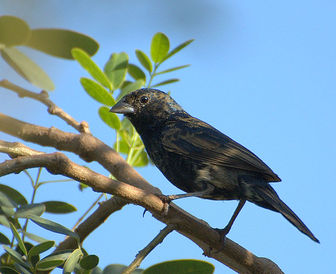Blue-black Grassquit
Adult Blue-black Grassquits are 10.2 cm long and weigh 9.3 g . They have a slender conical black bill. The male is glossy blue-black, with a black tail and wings; the white inner underwing is visible in flight or display. Female and immature birds have brown upperparts and dark-streaked buff underparts.

Original source: http://www.flickr.com/photos/dariosanches/2138326946/
Author: Dario SanchesPermission(Reusing this file)Livre
The Blue-black Grassquit is classified as Least Concern. Does not qualify for a more at risk category. Widespread and abundant taxa are included in this category.
Blue-black Grassquit feeds mainly on seeds. It is quite gregarious, and forms communal evening roosts. The male has a jumping display, often performed for long periods, which gives rise to the local name Johnny Jump-up. This is accompanied by a persistent wheezing jweeee call. More
Blue-black Grassquit In August 2009 was the first time that I could see this species, and this was in Gamboa, Panama. On Sunday I see them in San Mateo, here are too restless and somewhat difficult to photograph and the sun was caloris, but took them several photos of which these substantial cuts them them share. More
Similar to the Black-faced Grassquit, the Blue-black Grassquit is a bird of open countryside, scrub, grassland and garden. It is almost always seen near the ground where it feeds on grass seeds, or on a perch where it can be observed leaping into the air, spreading it More
The Blue-black Grassquit, Volatinia jacarina, is a small bird in the tanager family, Thraupidae. It was previously classified in the bunting and American sparrow family, Emberizidae. It breeds from southern Mexico through Central America, and South America as far as northern Chile, Argentina and Paraguay, and on Trinidad and Tobago. It is the only member of the genus Volatinia. Adult Blue-black Grassquits are 10.2 cm (4.0 in) long and weigh 9.3 g (0.33 oz). They have a slender conical black bill. More
jumping and singing male blue-black grassquit, Tiziu in Paramaribo. Blue-black grassquit in Suriname, Tiziu, Semillero chirr More
The Blue-black Grassquit feeds mainly on seeds. It is quite gregarious, and forms communal evening roosts. References - 1. ^ BirdLife International (2004). Volatinia jacarina. 2006. IUCN Red List of Threatened Species. IUCN 2006. www.iucnredlist.org. Retrieved on 12 May 2006. Database entry includes justification for why this species is of least concern * ffrench, Richard (1991). More
Blue-black Grassquit Costa RicaPastures and fields in Costa Rica have less bird species than forested habitats but there are some special birds that only live in the grass. One of these birds in Costa Rica is the Blue-black Grassquit. A small, common finch never found away from grassy fields the Blue-black Grassquit has some interesting behaviors. Identification A very small finch, the plumage of the Blue-black Grassquit differs strongly by sex. More
The Blue-black Grassquit feeds mainly on seeds. It is quite gregarious, and forms communal evening roosts. Scientific Classification Kingdom:Animalia Phylum:Chordata Some of this information thanks to Wikipedia. Share and Enjoy: * Print * Digg * Sphinn * del.icio. More

Original source: Dario Sanches
Author: Dario Sanches
Permission: Some rights reserved
Family : Emberizidae
Genus : Volatinia
Species : jacarina
Authority : (Linnaeus, 1766)
